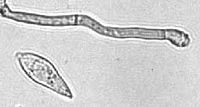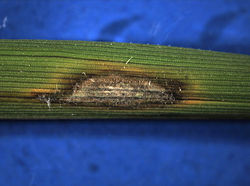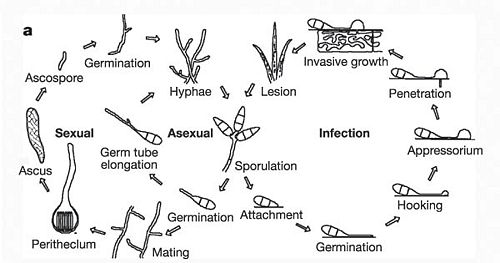Magnaporthe grisea: Difference between revisions
imported>Shridevi singh |
imported>Shridevi singh |
||
| Line 38: | Line 38: | ||
==Life Cycle== | ==Life Cycle== | ||
{{Image|M.grisea_life_cycle.jpg|center| | {{Image|M.grisea_life_cycle.jpg|center|500px|Life history of ''Magnaporthe grisea''. ''The Genome Sequence of the Rice Blast Fungus ''Magnaporthe grisea''(''dean et al. 2005'')}} | ||
==Pathology== | ==Pathology== | ||
Revision as of 07:45, 17 April 2009
For the course duration, the article is closed to outside editing. Of course you can always leave comments on the discussion page. The anticipated date of course completion is May 21, 2009. One month after that date at the latest, this notice shall be removed. Besides, many other Citizendium articles welcome your collaboration! |
| Magnaporthe grisea
A conidium and conidiogenous cell of M. grisea | ||||||||||||||
|---|---|---|---|---|---|---|---|---|---|---|---|---|---|---|
 | ||||||||||||||
| Scientific classification | ||||||||||||||
| ||||||||||||||
| Binomial name | ||||||||||||||
| Magnaporthe grisea |
Description and significance
Magnaporthe grisea, a plant-pathogenic fungus, is the causal agent of rice blast disease which is one of the greatest pathological threats to rice crops. It was thought to be localized only in developing nations, however for the past decade it has emerged as a severe problem in the United States, more recently in California. Yearly, rice that can feed an estimated 60 million people is destroyed by this disease. M.grisea is a well adapted fungus that can attack and penetrate its host plant with ease. More importantly, this fungus can also infect other important agricultures such as cereals, wheat, rye, pearl millet, and barley. The disease that is cause is then referred as blight disease or blast disease. Furthermore, M.grisea is thought of as a model organism in studies of fungal phytopathogenicity and host-parasite interactions.
Genome structure
Due to the destructive nature of this pathogen, sequencing the entire genome was necessary to understand the mechanisms of how the fungus causes disease. The complete genome of M.grisea was sequenced in 2005. M. grisea is a haploid and consists of ~40 Mb that are contained in 7 chromosomes (Talbot et al. 1993; Orbach 1996).The genome consists of a varied group of secreted proteins and a range of GPCR (G-Protein Coupled Receptors) genes. Furthermore, strong phylogenetic evidence of HGT’s (Horizontal Gene Transfer) has been found between M.grisea (ascomycete fungi) and oomycetes ( a distant relative).
Cell structure and metabolism
Magnaporthe grisea is a filamentous fungi. The spore tips contains a STM(Spore Tip Mucilage) adhesive that allows M.grisea to bind to its host. The binding of the spore begins the infection progression. After host-binding, specialized infection cells termed appresoria provide mechanical force and thus penetrates the plant cuticle and so gain entry into the internal tissues of the host.
M.grisea are infectious species and so obtain nutrients from their hosts. M.grisea is haploid and can reproduce sexually and asexually. M.grisea infectiious life cycle is asexual. The conidium is the infectious structure in this life cycle. After colonization of its host, lesions form. The lesions sites are locations of M.grisea sporulation. Soon enough, nearby plants become infected as well and so the spread of rice blast disease.
Ecology
M.grisea inhibits the host plant’s immune system, affecting the metabolism and cell signaling pathways. Adaptation of M.grisea is so efficient that even rice cultivars (bred to resist the disease) are infected. All above-ground parts of a host plant can be infected, but only if the stem, node, or panicle becomes infected will the grain set be lost. Rice is one of the most important staple food worldwide and control of this disease is utmost important.

